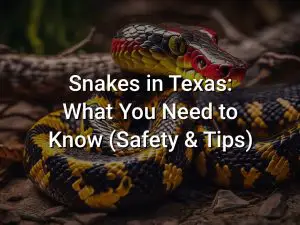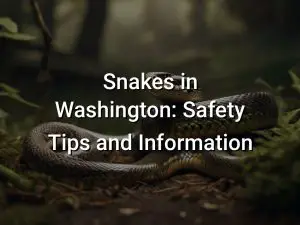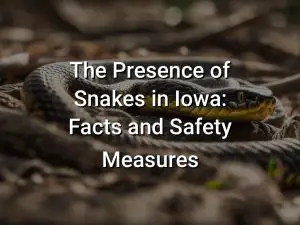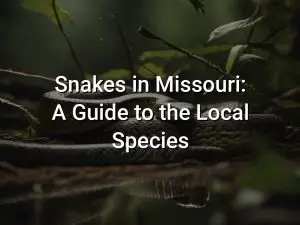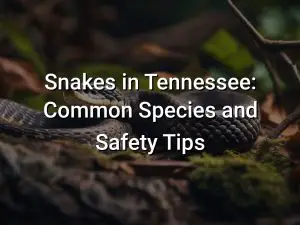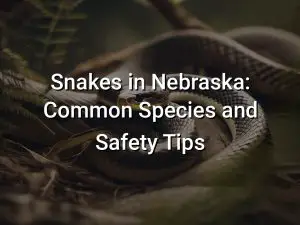Snakes in Alabama: A Guide to Identification and Safety Tips
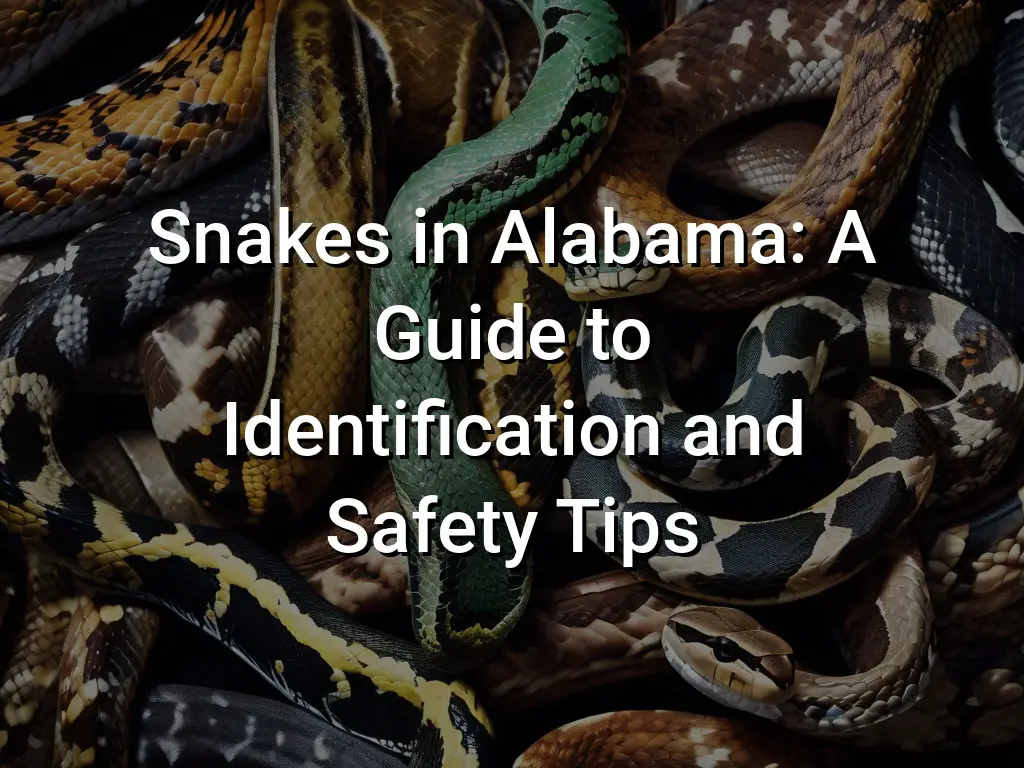
Snakes, while often feared and misunderstood, play an important role in Alabama’s ecosystem. Whether you’re a nature enthusiast or simply looking to stay safe during outdoor adventures, it’s crucial to be familiar with the various snake species found in the state. In this guide, we’ll provide you with essential information on identification and safety tips for the ten most common snakes in Alabama.
From the venomous Copperhead and Eastern Coral Snake to the non-venomous Black Racer and Rat Snake, each snake has unique characteristics and behaviors that can help you identify them. Additionally, we’ll offer valuable safety tips to ensure you and your loved ones can enjoy the beautiful outdoors of Alabama while minimizing any potential risks. So let’s dive in and learn more about the fascinating snakes of Alabama!
Quick Links
Copperhead
The Copperhead is a venomous snake that can be found in Alabama. It is named for the reddish-brown coloration of its head and body, which resembles the patina of a copper penny. Copperheads are relatively small, usually measuring between 2 to 3 feet in length.
Identification:
- Copperheads have a distinctive pattern of hourglass-shaped markings on their bodies. The pattern is darker in color and stands out against their lighter background.
- Their heads are triangular in shape and have a line extending from the eye to the corner of the mouth, known as a loreal pit.
Habitat and Behavior:
- Copperheads are typically found in wooded areas, rocky hillsides, and near bodies of water.
- They are mostly active during the evening and night, but can also be seen basking in the sun during cooler months.
- Copperheads are ambush predators and rely on their camouflage to blend into their surroundings while waiting for prey to pass by.
Danger and Safety Tips:
- Copperheads are venomous, and their bites can cause pain, swelling, and other symptoms. If bitten, it is important to seek immediate medical attention.
- When hiking or spending time in areas where copperheads may be present, wear sturdy shoes and stay on designated paths. Avoid tall grasses, rock piles, and other places where snakes may hide.
- Be cautious when reaching into or stepping over log piles, as copperheads may be hidden within.
- If you encounter a copperhead, keep a safe distance and do not attempt to handle or provoke the snake.
By being aware of the presence of copperheads and following these safety tips, you can reduce the risk of encountering a snake and minimize the chances of a negative interaction.
Eastern Coral Snake
The Eastern Coral Snake is a venomous snake species found in Alabama. It is characterized by its distinctive red, yellow, and black bands along its body. The red and yellow bands are adjacent to each other, while the black bands separate them.
Identifying an Eastern Coral Snake can be crucial for safety, as its venom can be extremely potent. It is important to remember the saying, “Red next to black, friend of Jack; red next to yellow, kill a fellow.” This mnemonic device helps distinguish the Eastern Coral Snake from the nonvenomous Scarlet Kingsnake, which has similar color patterns but with red and black bands adjacent to each other.
The Eastern Coral Snake prefers to live in wooded areas, marshes, and pine forests. It is a reclusive snake and rarely comes into contact with humans. However, if you do encounter an Eastern Coral Snake, it is important to maintain a safe distance and avoid any interaction.
If bitten by an Eastern Coral Snake, it is crucial to seek medical attention immediately. The venom of the Eastern Coral Snake affects the nervous system and can be life-threatening if not treated promptly. Do not attempt to handle or capture the snake, as this can increase the risk of being bitten.
Preventing encounters with the Eastern Coral Snake is essential for safety. When exploring natural areas in Alabama, wearing protective clothing such as long pants and boots can reduce the risk of snake bites. Additionally, being aware of your surroundings, avoiding tall grass or brush where snakes may hide, and using caution when stepping over logs or rocks can help minimize the chances of an encounter.
Overall, being able to identify and understand the Eastern Coral Snake is an important step in staying safe when encountering snakes in Alabama.
Eastern Diamondback Rattlesnake
The Eastern Diamondback Rattlesnake is one of the most venomous snakes in North America and is found throughout Alabama. It is a large and robust snake, with adults typically reaching lengths of 3 to 6 feet. The Eastern Diamondback Rattlesnake gets its name from the distinctive diamond-like patterns that cover its body.
This species is primarily found in pine forests, marshes, and coastal dunes. It has a preference for dry habitats and is often encountered in sandy or rocky areas. The Eastern Diamondback Rattlesnake is an ambush predator, relying on its camouflage to blend in with its surroundings and wait for prey to pass by.
When threatened, the Eastern Diamondback Rattlesnake will shake its rattle as a warning to potential predators. If the threat persists, it may strike, delivering a venomous bite. The venom of the Eastern Diamondback Rattlesnake is highly potent and can cause severe pain, swelling, and tissue damage. It is important to give this snake a wide berth and never attempt to handle or approach it.
If you encounter an Eastern Diamondback Rattlesnake in the wild, it is best to slowly back away and give it space. It is also important to wear sturdy, closed-toe shoes and watch where you step, as these snakes blend in well with their surroundings. Remember, snakes play a vital role in the ecosystem and should be respected from a safe distance.
Cottonmouth
The cottonmouth, also known as the water moccasin, is a venomous snake commonly found in Alabama. It is a large and stout snake, ranging in colors from brown to black, with a distinctive white mouth interior that gives it its name.
Cottonmouths are semi-aquatic and can be found near bodies of water such as swamps, marshes, and creeks. They are excellent swimmers and are known to be aggressive when threatened or cornered.
When identifying a cottonmouth, look for the following characteristics:
- Large size, ranging from 2 to 4 feet in length
- Thick body with a triangular-shaped head
- Pit organs on each side of the head, which detect heat
- Distinctive white mouth interior when open
It is important to exercise caution when encountering a cottonmouth as they are venomous. Their venom is hemotoxic, meaning it affects the blood and can cause tissue damage. If bitten by a cottonmouth, seek immediate medical attention.
To stay safe around cottonmouths, follow these tips:
- Avoid approaching or harassing the snake
- Be cautious near bodies of water, especially in dense vegetation
- Wear protective clothing and footwear when in areas where snakes may be present
- Do not attempt to handle or capture a cottonmouth
- Leave snakes alone and allow them to retreat if encountered
By being aware of the characteristics and behaviors of cottonmouths, you can better protect yourself and appreciate these fascinating creatures from a safe distance.
Timber Rattlesnake
The Timber Rattlesnake is a venomous snake species found in Alabama. It is also known as the Canebrake Rattlesnake and is one of the largest venomous snakes in the state. Here are some important facts and safety tips to know about this snake:
- The Timber Rattlesnake is typically brown or gray with dark crossbands along its body. It has a triangular-shaped head and a rattle at the end of its tail.
- These snakes prefer wooded areas, forests, and rocky hillsides. They are often found near streams or water sources.
- Timber Rattlesnakes are ambush predators, meaning they lie in wait for their prey, which consists of small mammals, birds, and amphibians.
- They are known for their rattling sound, which serves as a warning to potential threats. If you hear a rattling noise, move away slowly and do not provoke the snake.
- If you encounter a Timber Rattlesnake, it is important to give it space and avoid any unnecessary contact. Do not attempt to handle or provoke the snake.
- If you are bitten by a Timber Rattlesnake, seek immediate medical attention. Keep the bite area immobilized and below heart level while awaiting medical help.
- Preventing snake bites in forested areas can be done by wearing sturdy boots and long pants, staying on established trails, and using a flashlight at night.
Remember, snakes play an important role in the ecosystem, and it is best to observe them from a safe distance. By being aware and educated about snakes in Alabama, you can better appreciate their presence while ensuring your safety.
Rough Green Snake
The Rough Green Snake (Opheodrys aestivus) is a non-venomous snake commonly found in Alabama. It is known for its bright green coloration, which helps it blend in with its surroundings and camouflage from predators.
Identification:
- The Rough Green Snake has a slender body that can grow up to 3-4 feet in length.
- Its head is small and its eyes are large, giving it good eyesight for hunting insects.
- Its scales are smooth and shiny, contributing to its vibrant green appearance.
- Young snakes may have a yellowish tint to their green coloration.
Habitat:
The Rough Green Snake is commonly found in grassy areas, open forests, and near bodies of water such as ponds, swamps, and marshes. It can also be found in residential areas with gardens and shrubs, as it feeds on insects.
Behavior:
- The Rough Green Snake is primarily diurnal, meaning it is active during the day.
- It is a docile and non-aggressive snake, rarely biting humans.
- When threatened, the snake may release a musky odor as a defense mechanism.
Diet:
The Rough Green Snake is an insectivore, primarily feeding on insects such as crickets, grasshoppers, caterpillars, and spiders.
Safety Tips:
- The Rough Green Snake is harmless to humans and can be safely observed from a distance.
- If you encounter a Rough Green Snake, avoid touching or trying to handle it, as it may become stressed or agitated.
- Do not attempt to catch or kill the snake, as it plays an important role in controlling insect populations in its habitat.
It is always important to exercise caution and respect when encountering any snake in the wild. Understanding their behavior and habitat can help ensure a safe and peaceful coexistence.
Black Racer
The Black Racer, also known as the Southern Black Racer, is a non-venomous snake commonly found in Alabama. It is a fast and agile snake that is known for its black color and slender body.
The Black Racer is a harmless snake that plays an important role in controlling rodent populations. It feeds on small mammals, birds, and lizards, using its speed and agility to catch its prey. Although it is non-venomous, the Black Racer will bite if it feels threatened or cornered, so it is best to keep a safe distance and observe from afar.
This snake can be found in a variety of habitats, including fields, forests, marshes, and even suburban areas. It is a good climber and can often be seen basking in the sun on tree branches or fence posts.
If you encounter a Black Racer in Alabama, remember to give it space and avoid touching or attempting to handle it. It is always best to admire snakes from a safe distance and appreciate their important role in the ecosystem.
Southern Black Racer
The Southern Black Racer is a non-venomous snake species that can be found throughout Alabama. It is known for its sleek black color and its ability to move quickly, earning it the name “racer.”
The Southern Black Racer can grow up to 6 feet in length and has a slender body. It is a constrictor, meaning that it captures its prey by coiling around it and squeezing until it suffocates. Its diet consists mainly of small animals such as rodents, birds, and lizards.
While the Southern Black Racer is harmless to humans, it can be quite skittish and may try to escape if approached. If cornered or threatened, it may strike, but its bite is not venomous. It is important to remember that snakes play a vital role in the ecosystem by controlling rodent populations.
If you encounter a Southern Black Racer, it is best to admire it from a distance and allow it to continue on its way. These snakes are beneficial to have around as they help keep the balance of nature in check.
Rat Snake
The Rat Snake, also known as the Eastern Rat Snake, is a species of non-venomous snake commonly found in Alabama. It is one of the largest and most common snakes in the state, often reaching lengths of up to 6 feet or more.
Rat Snakes are known for their excellent climbing abilities and can be found in a variety of habitats, including forests, fields, and even residential areas. They are proficient hunters and feed on small mammals, birds, eggs, and other reptiles.
These snakes have a distinctive appearance, with a pattern of dark blotches on a lighter background color. The blotches may vary in shape and size, with some individuals having more uniform patterns than others.
Despite their name, Rat Snakes are not a threat to humans and are generally docile in nature. They will often try to flee when encountered but may become defensive if cornered or threatened. If you encounter a Rat Snake, it is best to keep a safe distance and allow it to retreat.
As with all snakes, it is important to remember that they play a vital role in the ecosystem and should be respected and left undisturbed whenever possible. If you are concerned about snakes in your area, it is best to contact a local wildlife expert for advice and assistance.
Eastern Hognose Snake
The Eastern Hognose Snake, also known as the Hognose Snake or Puff Adder, is a non-venomous snake native to Alabama. It is named for its upturned snout, which resembles a hog’s nose. This unique feature is used by the snake as a tool for burrowing in sandy or loose soil.
The Eastern Hognose Snake varies in coloration, but most individuals have a brown or gray background color with dark brown or black blotches. Some individuals may also have a reddish or yellowish coloration. They have small, keeled scales and a slightly flattened body.
Although the Eastern Hognose Snake is not venomous, it has a few interesting defense mechanisms. When threatened, it will often flatten its head, hiss loudly, and strike with its mouth closed. It may also engage in a behavior known as “playing dead,” where it will roll onto its back, open its mouth, and emit a foul odor. These tactics are usually enough to deter predators.
The Eastern Hognose Snake primarily feeds on toads, frogs, and other small amphibians. It has specialized rear fangs that help it subdue its prey. However, it is harmless to humans and rarely attempts to bite, even when handled.
If you encounter an Eastern Hognose Snake in the wild, it is best to observe it from a safe distance and avoid disturbing it. These snakes play a valuable role in controlling populations of small mammals and insects, making them a beneficial species to have in your local ecosystem.
Remember, snakes are an important part of Alabama’s natural heritage, and most species are harmless and prefer to avoid human contact. By understanding and respecting snakes, we can coexist with them and appreciate their beauty and ecological contributions.
Conclusion
Snakes in Alabama can be found in a variety of species, each with their own unique characteristics and safety considerations. It’s important to be able to identify these snakes and understand how to stay safe if you encounter them.
By following the safety tips outlined in this guide, you can minimize your risk of snake bites and enjoy the outdoors with peace of mind. Remember, snakes play an important role in the ecosystem and should be respected from a safe distance. Stay informed and educated about the snakes in your area, and always prioritize your safety when exploring nature.

